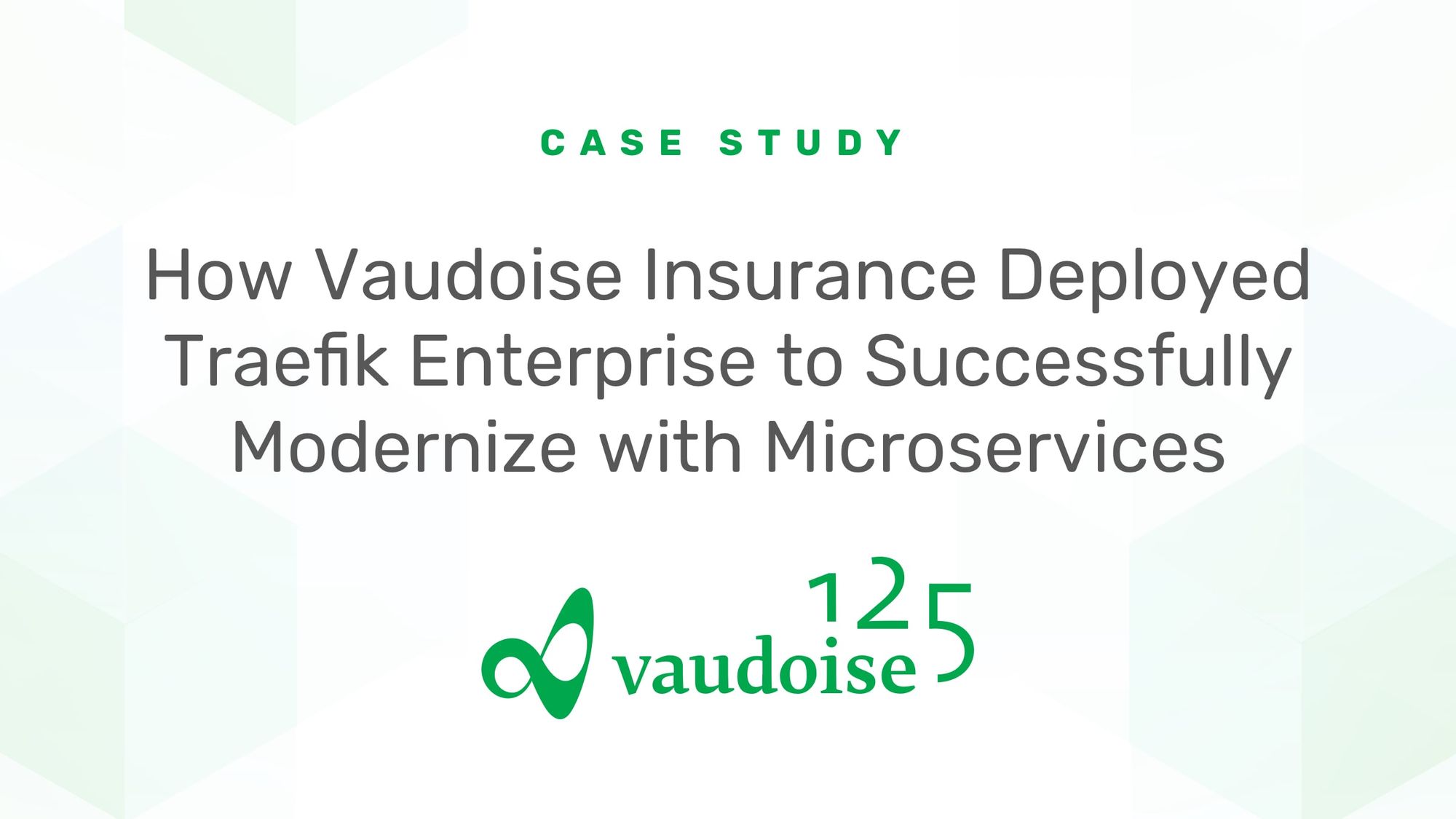How Vaudoise Insurance Deployed Traefik Enterprise to Successfully Modernize with Microservices

About Vaudoise Insurance
Vaudoise Insurance is the only independent private insurance company with a decision-making center in French-speaking Switzerland. Founded in 1895, it is one of the ten largest private insurers in the Swiss market. Vaudoise provides individuals and SMEs with high-level advice and solutions in all areas of insurance and pension provision. Through its network of around 100 branches across Switzerland, it offers its customers local service, in terms of both advice and claims settlement. The Group employs roughly 1,550 people, including around 100 apprentices.
Overview
How do you modernize a company with 125 years of history? Vaudoise Insurance entered the digital age decades ago, yet the technical debt incurred by years of legacy computing was becoming too much to manage. Its monolithic systems were burdensome to upgrade and rolling out new features required coordination from multiple teams. The pace of change was too slow.
Vaudoise’s technical teams needed to become more agile to match the pace of today’s business environment. Its 150-200 IT staffers shared the task of managing some 300 applications, and too many of these were silos. What the company’s development teams wanted was to expose more of its internal data via APIs, making it easier to build new, lightweight applications based on microservices.
Complicating matters was the fact that insurance is a highly regulated industry, particularly when it comes to data privacy. That meant Vaudoise would need to continue to host and manage some of its applications on premises, and any new technologies introduced could not significantly add to the existing management burden.
Challenge
Vaudoise’s strategy was to begin developing new applications as Docker containers, while simultaneously modernizing its monolithic, legacy applications by decomposing them into containerized services. The intent was that this would not only speed time-to-delivery for new applications, but it would also allow development teams to experiment with new technologies (such as NoSQL databases) that simply weren’t available to their legacy systems.
Damien Desvignes and Patrick Monbaron, application lifecycle management (ALM) engineer and system engineer at Vaudoise, belong to the multidisciplinary team responsible for the Docker platform. The company chose Docker Enterprise as its container platform, both because of its proven technology and because its Docker Swarm mode orchestration layer was significantly less complicated to deploy than alternatives (such as Kubernetes).
Still this left Damien and Patrick’s team with another problem. Now that it had decided how it would host its containers and services, how would it publish them?
"We needed a tool that would allow us to dynamically publish new services, or change the configuration of existing services, that was simple to handle and that did not need a restart, unlike the usual nginx-based tools.” Patrick Monbaron, system engineer at Vaudoise
“As an insurance company, security and service uptime are two of our highest requirements. Traefik Enterprise provides high availability and encryption capabilities necessary for Vaudoise, in a single, easy-to-use solution.” Patrick Monbaron, system engineer at Vaudoise
Solution
Prior to the company initiative, Damien had successfully used Traefik for over 3 years and was confident that its ease-of-use, versatile feature set, and broad ecosystem made it the right choice for application networking with containers.
As Vaudoise started this new containerized application strategy, Damien immediately sought out Traefik Enterprise to help satisfy the company’s production networking requirements. Traefik Enterprise provides out-of-the-box high availability (HA) and security features that are essential for a business operating in the insurance industry. For example, Traefik Enterprise can interface with the Docker Universal Control Plane (UCP) to enable role-based access control (RBAC) on the cluster. Additionally, Traefik Enterprise includes fast, responsive enterprise support from Traefik Labs, giving Vaudoise the peace of mind of having a partner to rely on.
From an operations perspective, Patrick and his infrastructure team benefited from using Traefik Enterprise by securing and managing Docker Swarm ingress traffic, making it faster and easier to deploy new services. Even HTTPS encryption is now centrally managed by the infrastructure team, leaving developers free to concentrate on software delivery, without a lot of cross-team coordination.
“Developers are a lot more autonomous than before. Dev teams can manage the rewrite rules on their own, for example, which was not possible before.” Patrick Monbaron, system engineer at Vaudoise
Bottom Line
Vaudoise Insurance is only at the beginning of its journey with containers and Traefik Enterprise. Damien and Patrick are looking forward to working with features introduced in recent versions of Traefik, including the ability to support applications that use the TCP and UDP protocols, in addition to HTTP. Emerging technologies such as service mesh – a feature offered by Traefik Enterprise 2.2 – are also under consideration.
Down the road, Vaudoise may even consider moving from Docker Swarm to a more full-featured container orchestrator, such as Kubernetes, confident that Traefik Enterprise will continue to support that new environment.
Already, however, the features of Traefik Enterprise – including enterprise support from Containous – have been instrumental in Vaudoise’s IT modernization journey. Traefik’s vibrant and active ecosystem, coupled with the enterprise features and evolving technology roadmap of Traefik Enterprise, allow Vaudoise to proceed with confidence, knowing it will be well-positioned for continued success as it moves into the next phase of its long history
What’s Next?
- Discover Traefik Enterprise, and request your demo.



